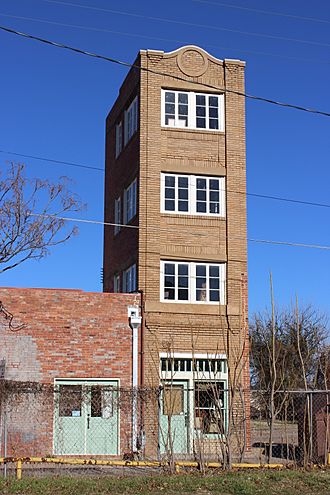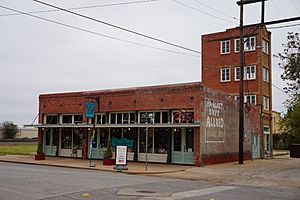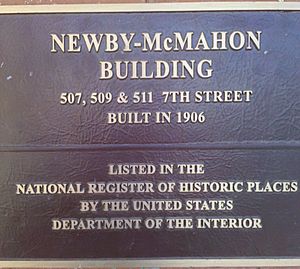World's littlest skyscraper facts for kids
Quick facts for kids Newby–McMahon Building |
|
|---|---|
 |
|
| General information | |
| Type | Mixed-use |
| Location | Wichita Falls, Texas, United States |
| Coordinates | 33°54′52″N 98°29′23″W / 33.9144°N 98.4897°W |
| Construction started | 1919 |
| Completed | 1919 |
| Opening | 1919 |
| Cost | $200,000 ($3,114,836.36 In 2020) |
| Height | |
| Roof | 12.2 m (40.0 ft) |
| Technical details | |
| Floor count | 4 habitable floors |
| Floor area | 40 m2 (430 sq ft) |
| Design and construction | |
| Architect | Michael Beards |
| Structural engineer | J.D. McMahon |
| Main contractor | J.D. McMahon |
|
Newby–McMahon Building
|
|
|
U.S. Historic district
Contributing property |
|
| Part of | Depot Square Historic District (ID03001552) |
| Designated CP | February 4, 2004 |
The Newby–McMahon Building is a very famous, tiny building in Wichita Falls, Texas. People often call it the world's littlest skyscraper. It stands at 701 La Salle, right in the heart of downtown. This building is made of red brick and cast stone, designed in a style called Neoclassical.
Even though it's called a skyscraper, it's only 40 ft (12 m) tall! Its outside measurements are 18 ft (5.5 m) deep and 10 ft (3.0 m) wide. Inside, it's even smaller, about 12 ft (3.7 m) by 9 ft (2.7 m). A lot of the inside space is taken up by steep, narrow stairs.
The building was finished in 1919. Many people believe it was built as part of a trick by a clever con artist. Because of this, the building caused a lot of embarrassment for the city. Later, in the 1920s, it became famous when Robert Ripley featured it in his Ripley's Believe It or Not! column. That's how it got its lasting nickname. Today, the Newby–McMahon Building is a special part of the Depot Square Historic District in Wichita Falls. It's also a Recorded Texas Historic Landmark.
Contents
Why Was This Tiny Skyscraper Built?
The Oil Boom in Wichita Falls
In 1912, a huge amount of oil was found near Burkburnett, Texas, a small town in Wichita County, Texas. This discovery turned Burkburnett and nearby areas into "boomtowns." Their populations and economies grew incredibly fast. By 1918, about 20,000 new people had moved to the area. Many residents of Wichita County became rich very quickly.
As people rushed in looking for good jobs, the city of Wichita Falls became more important. At first, Wichita Falls didn't have enough buildings for all the new businesses. Major deals for oil and land were even done on street corners or in tents!
The Plan for a New Building
The Newby–McMahon Building is a four-story brick building. It's located near the train station in downtown Wichita Falls. It was built in 1906 by Augustus Newby. J.D. McMahon, an engineer who worked with oil rigs, had an office in the original Newby Building.
Local stories say that in 1919, McMahon announced a plan. He would build a tall annex next to the Newby Building. This new building would help solve the city's need for office space. Investors were very excited to put their money into the project. McMahon collected US$200,000 from these investors. He promised to build a tall office building across from the St. James Hotel.
The trick McMahon used was in the legal papers. The height of the building was listed as 480" (inches), not 480' (feet). The investors didn't seem to notice this small detail. McMahon never actually said the building would be 480 feet (150 m). The blueprints he showed clearly said the building would have four floors and be 480 inches (12 m) tall.
Building and Legal Problems
McMahon used his own construction teams to build the McMahon Building. He built it on a small piece of land next to the Newby Building. He didn't even get permission from the land owner first!
When the investors saw the tiny building, they sued McMahon. But a local judge said the deal was legally binding. The investors did get a small amount of money back from the elevator company. That company refused to install an elevator once they saw how small the building was. At first, there wasn't even a stairway inside, just a ladder! By the time the building was finished, McMahon had left town with the rest of the investors' money.
Life of the Building Through the Years
Early Days and Fame
When the Newby–McMahon Building opened in 1919, it was a big embarrassment for Wichita Falls. The ground floor had six desks for the first companies that moved in. For most of the 1920s, only two businesses used the building. During this time, it became famous as "the world's littlest skyscraper" in Robert Ripley's Ripley's Believe It or Not! column.
The oil boom in Texas ended a few years later. The building was left empty and boarded up in 1929. This was when the Great Depression hit North Texas, and office space became cheap. In 1931, a fire badly damaged the building, making it unusable for years.
Saving the Building
After the Great Depression, different businesses used the building. These included barber shops and cafés. The building was bought and sold many times. It was even planned for demolition several times. But local people always stepped in to save it. Eventually, the city of Wichita Falls took ownership.
In 1986, the city gave the building to the Wichita County Heritage Society (WCHS). They hoped the WCHS would restore it. This would make it a valuable part of the Depot Square Historic District.
Restoration Efforts
By 1999, the Newby–McMahon Building was too expensive for the WCHS to keep up. In 2000, the city hired an architectural firm to help fix the crumbling building. The architects became very interested in the building's history. They teamed up with another local business, Marvin Groves Electric, to buy it. In December 2000, the city council allowed the WCHS to sell the building for $3,748 (equivalent to $6,369 in 2022).
On June 11, 2003, a strong storm hit Wichita Falls. Part of the building's brick wall was knocked down. This damage was fixed, but the full restoration was delayed until late 2005. The city council gave $25,000 to help with the restoration. The total cost to fix the building was over $254,000. The rest of the money was paid by the new owners.
What is the Building Used for Today?
The Newby–McMahon Building has survived many challenges. These include tornadoes, a fire, and years of being ignored. It is now part of the Depot Square Historic District. This area is a Recorded Texas Historic Landmark and is listed on the National Register of Historic Places.
Even though it's called a skyscraper, it's never been tall enough to actually be one. After its renovation, an antiques shop called Antique Wood opened on the ground floor in 2006. Since 2013, a furniture and home décor shop called Hello Again has used the entire building. Sometimes, different local artists also rent space on the upper floors.
The Newby–McMahon Building is featured in a 2006 documentary film. The film is called Wichita Falls: The Future of Our Past. It looks back at the city's interesting old buildings.
Images for kids
See also
 In Spanish: Newby-McMahon Building para niños
In Spanish: Newby-McMahon Building para niños




